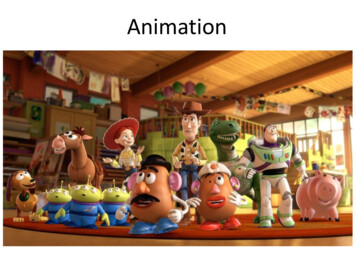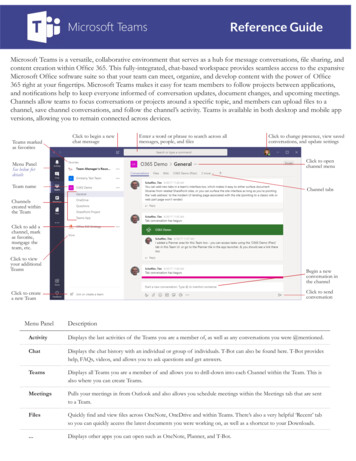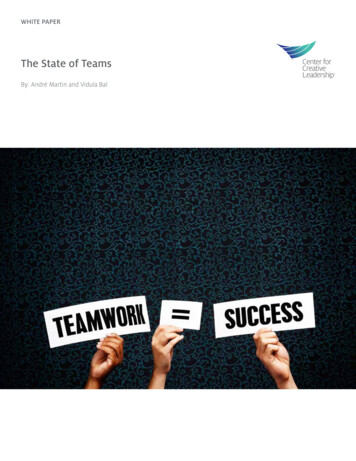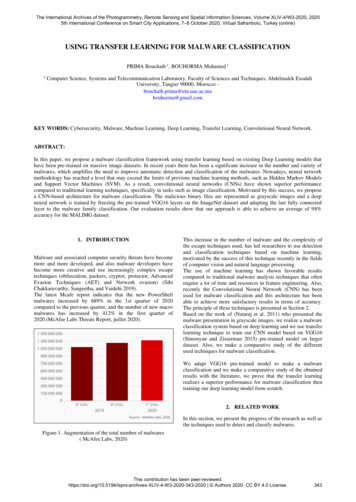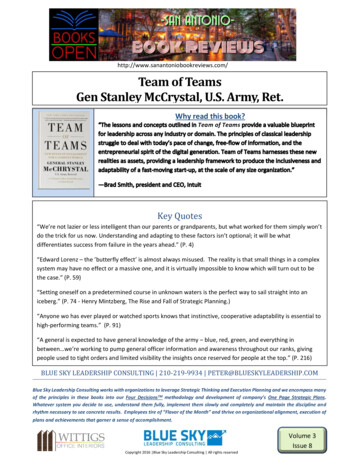
Transcription
http://www.sanantoniobookreviews.com/Team of TeamsGen Stanley McCrystal, U.S. Army, Ret.Why read this book?Team of TeamsKey Quotes“We’re not lazier or less intelligent than our parents or grandparents, but what worked for them simply won’tdo the trick for us now. Understanding and adapting to these factors isn’t optional; it will be whatdifferentiates success from failure in the years ahead.” (P. 4)“Edward Lorenz – the ’butterfly effect’ is almost always misused. The reality is that small things in a complexsystem may have no effect or a massive one, and it is virtually impossible to know which will turn out to bethe case.” (P. 59)“Setting oneself on a predetermined course in unknown waters is the perfect way to sail straight into aniceberg.” (P. 74 - Henry Mintzberg, The Rise and Fall of Strategic Planning.)“Anyone wo has ever played or watched sports knows that instinctive, cooperative adaptability is essential tohigh-performing teams.” (P. 91)“A general is expected to have general knowledge of the army – blue, red, green, and everything inbetween we’re working to pump general officer information and awareness throughout our ranks, givingpeople used to tight orders and limited visibility the insights once reserved for people at the top.” (P. 216)BLUE SKY LEADERSHIP CONSULTING 210-219-9934 PETER@BLUESKYLEADERSHIP.COMBlue Sky Leadership Consulting works with organizations to leverage Strategic Thinking and Execution Planning and we encompass manyof the principles in these books into our Four DecisionsTM methodology and development of company’s One Page Strategic Plans.Whatever system you decide to use, understand them fully, implement them slowly and completely and maintain the discipline andrhythm necessary to see concrete results. Employees tire of “Flavor of the Month” and thrive on organizational alignment, execution ofplans and achievements that garner a sense of accomplishment.Volume 3Issue 8Copyright 2016 Blue Sky Leadership Consulting All rights reserved
http://www.sanantoniobookreviews.com/A journey – not a “how to” manual11. The Proteus Problem identifies that the challenge lies not in our enemy (competitor) but the newenvironment in which we operate.2. From Many, One lays out the magic and myths of teams. What creates trust and common purpose.3. Sharing shows how to deal with continual change and increasing complexity and the concept ofshared consciousness.4. Letting Go delves into empowered execution in an organization and getting decisions made at theright level.5. Looking ahead ties these concepts togetherThe Proteus ProblemIt was September 2004 when Al Qaeda decimated the crowd at a sewage plant ceremony that the questionthat resulted in TEAM OF TEAMS was asked. “if we were the best of the best, why were such attacks notdisappearing, but in fact increasing? Why were we unable to defeat an under resourced insurgency? Whywere we losing?” (P. 19) (General Stanly McChrystal (U.S. Army, 2015)TEAM of TEAMSA large command that captured at scale the traits of agility normally limited to small teams.Horatio Nelson’s defeat of the Spanish ships is often remembered as a strategic success yet “Nelson’s realgenius lay not in the clever maneuver for which he is remembered, but in the years of innovativemanagement and leadership that preceded it.” (P. 31)Frederick Taylor was the world’s first management guru and he changed the world. “Though the notion of a“best practice” is now commonplace, at that time a workman’s methods were part of his art; variable,personalized, and a matter of pride.” (P. 40). Taylor legitimized “management” as a discipline and createdthe line between thought and action that “managers did the thinking and planning, while workersexecuted.”A lesson to be learned is that if all we do is find a solution to a past problem we will likely miss the newthreats that come our way. The French built the Maginot Line to ensure the horrors experienced in WW1would not be repeated but it was of little use to the German attack of WW2.1McChrystal, Stanley, Team of Teams; Portfolio/Penguin, copyright 2015, Page 6-7Book Review: Team of TeamsPage 2 7Volume 3Issue 8
http://www.sanantoniobookreviews.com/The book offers great insight into the difference between COMPLICATED vs. COMPLEX. Complicatedsystems are much more likely to be predictable whereas the complex is often unpredictable. And becausethe world has become so much more complex it has become that much less predictable.“Resilience thinking is a burgeoning field that attempts to deal in new ways with the new challenges ofcomplexity Resilient systems are those that can encounter unforeseen threats and, when necessary, putthemselves back together again.” (P. 79) The key lies in shifting our focus from predicting to reconfiguring.When you KNOW what the right thing is efficiency makes sense yet when you lack that certainty you need toopt for the flexibility to do things right.From Many, One“The formation of SEAL teams is less about preparing people to follow precise orders than it is aboutdeveloping trust and the ability to adapt within a small group.” (P. 97)Great teams TRUST one another, KNOW one another, RELY on one another, Put their LIVES in one another’shands. Great teams can’t predict their situations BUT can predict how other members of the team will react!For great teams you must be aligned to the overall mission and purpose of your organization and be in it forthe team and not yourself. “Purpose affirms trust, trust affirms purpose, and together they forge individualsinto a working team.” (P. 100)The field of “emergence” – how complex patterns and forms can arise from a multiplicity of simple, lowlevel interactions. Think of an ant colony.The airline industry changed from risk mitigation strategy to a risk adaptation focus after the crash of United173 in 1978. 70% of aviation deaths could be attributed to human error even as safety innovationsincreased exponentially. The command and control focus needed to be replaced by real timecommunication and team adaptation capabilities as the complicated became the complex. Crew ResourceManagement (CRM) or charm school.MECE – Mutually exclusive and collectively exhaustive e.g. paying and nonpaying customers. (P. 118)Non MECE example is a football team – they can’t rely on the coach to tell them what to do play by play.Team of Teams“On a single team, every individual needs to know every other individual in order to build trust, and theyneed to maintain comprehensive awareness at all times in order to maintain common purpose – easy with agroup of twenty-five, doable with a group of fifty, tricky above one hundred, and definitely impossible acrossa task force of seven thousand. But on a team of teams, every individual does not have to have arelationship with every other individual; instead, the relationships between the constituent teams need toresemble those between individuals on a given team.” (P. 128)Book Review: Team of TeamsPage 3 7Volume 3Issue 8
http://www.sanantoniobookreviews.com/Seeing the SystemThe fallacy of “need to know” silos creates a system where you can no longer predict effectively and youmiss critical links in the picture. For a plan to work “everyone has to see the system in its entirety.” Greatteams know that to counter unpredictability, they need to be able to improvise and react to thecircumstances on the field.The story of how NASA changed its siloed organization into a developmental organization is inspiring eventoday. Their “systems engineering/management created a “mechanism with a continuous cross-feedbetween the right and left side of the house.” (P. 149) ELDO – the European space initiative – failedmiserably “from shortfalls of organizational communication – devastating “interface failures”, orblinks Europe’s lag was not a question of money but of “methods of organization”.” (P. 151)NASA set the stage. “whatever efficiency is gained through silos is outweighed by the costs of “interfacefailures.” And proved that the cognitive ‘oneness’ – the emergent intelligence – that we have studied insmall teams can be achieved in larger organizations, if such organization are willing to commit to thedisciplined, deliberate sharing of information.” (P. 151)NOTE: this changed dramatically after Apollo and they became a bureaucratic machine with the horrors ofchallenger disaster.The key seemed to be “to fuse generalized awareness with specialized expertise”. SHARED CONSCIOUSNESS“Physical space has for a century been used to facilitate and enforce efficiency and specialization.” (P. 157) Pentagon designed to move between any location within 7 minutes yet now everything is ‘accessprotected’ so you have independent, discrete groups “that might as well be spread around theglobe.”Large, tall buildings with executive suites, private entrances or elevators“How we organize physical space says a lot about how we think people behave; but how people behave isoften a by-product of how we set up physical space.” (P. 159) [Bell Labs, NASA, Google, Bloomberg’s“bullpen” became models for their Joint Operations Center (JOC)]“The structure and symbolism of the Task Force’s new nonhierarchical space was critical, but ourorganization would not be reborn by just moving furniture around. We needed to renovate ourorganizational culture as well.” (P. 163)The O&I briefings lasted 2 hours daily and were attended by 7,000 people. “By having thousands ofpersonnel listen to these daily interactions, we SAVED an incalculable amount time that was no longerneeded to seek clarification or permission.” (P. 169)Book Review: Team of TeamsPage 4 7Volume 3Issue 8
http://www.sanantoniobookreviews.com/A key to developing their Team of Teams was beating the “Prisoners Dilemma”. This required building trustand solid relationships with partners. Embedding team members resulted in supplying your best as theyrepresented you. Gaming theory found a winning strategy in “Tit for Tat” (see page 183).“What we saw in the Task Force was that while cooperation began as conscious system 2 decision (they’llhelp me later if I help them now; cooperation is in my interest), a track record of productive collaborationsled to reflexive, system 1 cooperation – in other words, real trust. Furthermore, this trust had a viral effect:once it passed a certain threshold, it became the norm.” (P. 183)The GM ignition switch recallGM became the behemoth of the car industry when it created “decentralized operations with coordinatedcontrol” or silos. That worked great for much of the 20th century but became their Achilles heel whenchanging competitive realities dictated speed and agility as crucial to continued success. Silos created: Internal rivalriesCompetitive cultureInhibited communicationsMistrust between teamsLittle cross-silo information flowA two-dollar easy fix was ignored for 10 years because no one could connect the dots – airbags and ignitionsystems were overseen by two different teams and the easy fix was discussed but never addressed.“Top down coordination of siloed efforts works only if those on top actually understandhow everything will interact.” (P. 193)Alan Mulally, CEO for Ford in 2005, created “One Ford” and “figured out a way to profitably produce cars inthe United States.” (P. 195) As Mulally put it, “Working together always works. It always works. Everybodyhas to be on the team. They have to be interdependent with one another.” (P. 195)Book Review: Team of TeamsPage 5 7Volume 3Issue 8
http://www.sanantoniobookreviews.com/Part IV – Letting Go1. “The Navy is the only service that uses the acronym UNODIR(Unless Otherwise DIRected), by which a commanding officerinforms the boss of a proposed course of action, and only if theboss overrides it will it not be taken. The subordinate is informingthe boss, not asking permission.” (P. 207)2. “ our priority should be reaching the best possible decision thatcould be made in a time frame that allowed it to be relevant. Icame to realized that, in normal cases, I did not add tremendousvalue, so I changed the process. I communicated across thecommand my thought process on decisions like airstrikes, and toldthem to make the call. Whoever made the decision, I was alwaysultimately responsible, and more often than not those below mereached the same conclusion I would have, but this way our teamwould be empowered to do what was needed.” (P. 209)3. Ritz-Carlton – “Instant guest pacification is the responsibility ofeach employee.” Nordstrom – one rule: use good judgment in allsituations.4. Empowerment should be done “only if the recipients of newfoundauthority have the necessary sense of perspective to act on itwisely.” (P. 216)5. “Eyes On – Hands Off” “I was most effective when I supervisedprocesses – from intelligence operations to the prioritization ofresources – ensuring that we avoided the silos or bureaucracy thatdoomed agility, rather than making individual operationaldecisions.” (P. 218)Lead like a gardener and not like a chess master1. Gardeners plant and harvest, but more than anything, theytend.” (P. 229)2. “Regular visits by good gardeners are not pro forma gesturesof concern – they leave the crop stronger. So it is withleaders.” (P. 229)KEY TAKEAWAYS Action Items--“For a soldier trained at West Point as an engineer, the idea that aproblem has different solutions on different days was fundamentallydisturbing. Yet that was the case. “-“A system requires shared consciousness before it can reap thebenefits of empowered execution.” (P. 244)-Book Review: Team of TeamsEfficiency, management,organizational hierarchiesneed to shift as they are nomatch for the complexities ofour world today.It ALWAYS comes down toTRUST, knowing your corepurpose, and your WHYTo “see the system” requiresLOTS of COMMUNICATIONand cross pollination of teams– SHARED CONSCIOUSNESS.“Empowered executionwithout shared consciousnessis dangerous.” (P. 244)Think Navy – UNODIR; RitzCarlton; EYES ON – HANDSOFFBe a gardener, not a chessmasterOur old mental models will nolonger direct us to thesolutions necessary in the 21stcenturyWhen did you have a teamexperience that waspositive and memorable?Who is YOUR ‘enemy’ andhow do you need tochange to defeat them?How do you create ‘sharedconsciousness’ in yourorganization?Page 6 7Volume 3Issue 8
http://www.sanantoniobookreviews.com/Calendar of EventsrdSeptember 23October 28thNovember 18thDecember 16thFriday September 23rd8:00 AM – Wittigs8:00 AM – Wittigs8:00 AM – Wittigs8:00 AM – WittigsTriggers – Marshall GoldsmithThe Alchemist – Paulo CoelhoScaling Up – Mastering Rockefeller Habits 2.0 - HarnishThe Ideal Team Player – Patrick LencioniIn Triggers Goldsmith shows how we can overcome the trigger points in our lives,and enact meaningful and lasting change. Change, no matter how urgent and clearthe need, is hard. Knowing what to do does not ensure that we will actually do it. Weare superior planners, says Goldsmith, but become inferior doers as our environmentexerts its influence through the course of our day. We forget our intentions. Webecome tired, even depleted, and allow our discipline to drain down like water in aleaky bucket. In Triggers , Goldsmith offers a simple “magic bullet” solution in theform of daily self-monitoring, hinging around what he calls “active” questions. Theseare questions that measure our effort, not our results. There’s a difference betweenachieving and trying; we can’t always achieve a desired result, but anyone can try.Goldsmith details the six “engaging questions” that can help us take responsibility forour efforts to improve and help us recognize when we fall short. (Amazon review)Friday October 28thThe AlchemistFriday November 18thBook Review: Team of TeamsPage 7 7Volume 3Issue 8
Team of Teams Gen Stanley McCrystal, U.S. Army, Ret. Why read this book? Team of Teams BLUE SKY LEADERSHIP CONSULTING 210-219-9934 PETER@BLUESKYLEADERSHIP.COM Blue Sky Leadership Consulting works with organizations to leverage Strate
